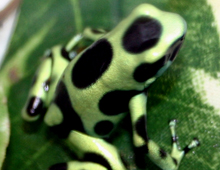Description: This frog is dark brown or glossy black and typically has mint, metallic-like green stripes, bands and spots, making this one of the most colorful of the Dendrobates. The pattern variations are as varied as their colors (depending on habitat and range), including forest, lime and emerald green to yellow, turquoise and cobalt blue. They have sucker like discs on the ends of their toes which create a suction to help them climb. The poison in their glands comes from the ants they ingest. Their bright colors are warning for would-be predators of their poison.
Size: Dendrobates auratus are considered large in size, varying from 1 to more than 1.6 inches (2.5- 4.2 cm) in length; females are slighter larger.
Behavior: They are very active during the day in vegetative moist areas, such as leaf litter. They are aggressive and territorial. This species is not entirely terrestrial, often seen in trees where they forage for ants, and other food items and often carry their tadpoles to tree holes or water holes such as the centers of bromeliads.
Diet: They eat small invertebrates, preferring ants which are captured on their sticky tongues.
Senses: They use their excellent sense of vision for capturing prey. Touch and chemical cues are also believed to be used.
Communication: Mating calls by males are continuous throughout the day from ground litter. The call is described as a bird-like, buzzing sound and a musical high-pitched repetitious sound. Colors and stances are visual communicators.
Reproduction: Courtship is at ground level where the mating ritual is quite elaborate. The male frogs will fight each other, and when the females have chosen their mate, the males stay in their own territories. After the eggs are laid (average number is four to six), the males tend the eggs. During the 10 to 14 days of incubation, the male may mate with other females and actually care for clutches at the same time. After hatching, the tadpoles are carried to water holes where they remain until metamorphosis occurs.
Habitat/range: This frog lives on rainforest floors near small streams or pools of water and can be found in southern Nicaragua, Costa Rica, Panama, Brazil, Bolivia and Colombia.
Status: IUCN – Least Concern; CITES Appendix II.



